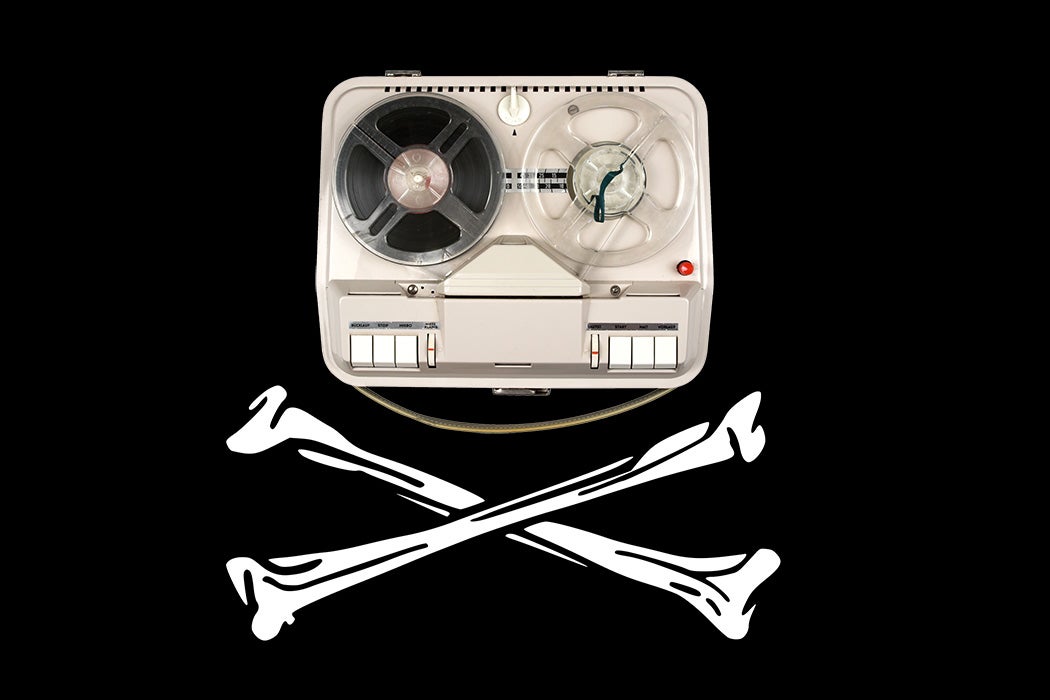Maybe you know about bootleggers, the rum-runners one step ahead of the law in Prohibition America. But there’s some regional flavor to it, as historian Alex Sayf Cummings explains, bootlegging is “bound up in the mythology of an iconic southern industry and pastime, NASCAR racing, as the sport originated among southerners who souped up their cars to move illicit booze and evade law enforcement.” The South, Cummings notes, is also home to another kind of bootlegging, this one less moonshine, more music. In the 1960s, the region was “emerging as a major center of pirate music production.”
Bootlegged music was an unintended result of new technology. When most music was released as records, it was highly controlled by pressing plants and the major labels. Then, in the 1940s, magnetic tape entered the scene, allowing “a new and more flexible form of recording.” Even with that advancement, the technology was still mainly used by those in the music business and “a small number of high-fidelity enthusiasts.” But by the 1960s, recording technology like 8-tracks and cassettes made what was once a niche activity much more widespread. And as Cummings writes, “media production decentralized and spread across the nation, as everyone from self-described socialists to mere profiteers seized the opportunity to reproduce and distribute sound recordings.”
Now anyone could be their own recording studio. And in the South, a lot of people wanted to. When the federal government began to crack down on piracy, they discovered “that small towns in the South were connected to [bootlegging] networks that spanned the country, north to south and east to west,” writes Cummings.
In some ways, this was trading one type of bootlegging for another, Cummings explains. In the eighteenth century, rural farmers often “made their own alcohol due to the remoteness of their homesteads and the lack of access to markets.” In 1810, one North Carolina county had twenty-one corn and wheat mills, but sixty-two stills making corn liquor. Bootlegging continued well into the Prohibition era as it was a reliable way to make money. This only solidified the region’s moonshine-on-wheels reputation in popular imagination. And as Cummings explains, “Law sets the boundaries of who can legitimately print money, make liquor, or reproduce a creative work, but the bootlegger disregards such limits and turns his tape recorder or still into a site of home production.”
Whether it was a still or a blank tape, “the history of bootlegging both liquor and music is filled with roguish characters who did not toil discreetly in the shadows.” And like booze, the music bootleggers ran the gamut from small-time music-lovers who served the collectors’ market, to those looking for fast money, to “career criminals with ties to the Mafia.” There were even bootlegging collectives that created their own labels and “vow[ed] to free music from corporate control and divide proceeds from record sales equally among their workers.” “Rubber Dubber,” a member of one such collective, even “sent his records to be reviewed in Rolling Stone and gave interviews to the press.” And though most bootleggers were men, a few women, like rock bootlegger Vicki Vinyl, made names for themselves.
Though areas like Chicago, Los Angeles, and New York got most of the attention from the FBI, southern states were active bootlegging centers. In fact, one of the largest suppliers of bootlegged music to the East Coast was located in Charlotte, North Carolina. Other facilities were found in “small towns such as Caroleen and Ellenboro, as well as a mobile home in Tryon, N.C.”
Weekly Newsletter
Sound 8, a company out of Atlanta, “advertised pirated tapes as ‘simulations’ of major hits, offering them to potential distributors for 90 cents each.” These were labeled as recorded by “Sound 8 singers and musicians.” But according to federal investigators, these singers and musicians didn’t exist; these were bootlegged tapes of existing records. This sound-alike practice was actually a popular gambit as it was legal to record cover versions that sounded just like the original as long as “the label did not try to mislead consumers by using the name or likeness of the original performer.” And since these were legal, entities like Sound 8 could claim they were “just uncanny imitations.”
In the 1960s and ’70s, music piracy took hold in all corners of the US, but maybe nowhere more than the South, particularly North Carolina. As Cummings writes, “The tape deck was the new still, and Tar Heels jumped at the chance to connect Gaffney, Nashville, and New York in a new bootleg empire.”
Support JSTOR Daily! Join our membership program on Patreon today.







